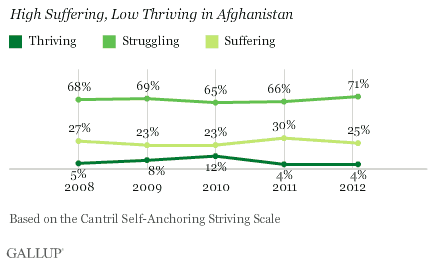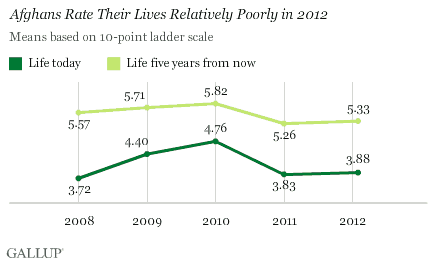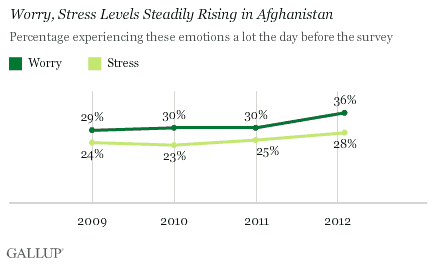WASHINGTON, D.C. -- Afghans' views of their lives improved little between 2011 and 2012. One in four rate their lives poorly enough to be considered "suffering" -- a ratio essentially unchanged from the year before -- and the percentage who are "thriving" remained flat, at 4%. The majority of Afghans (71%) are still "struggling."

Gallup classifies respondents as thriving, struggling, or suffering according to how they rate their current and future lives on a ladder scale with steps numbered from 0 to 10, based on the Cantril Self-Anchoring Striving Scale, where 0 represents the worst possible life and 10 represents the best possible life. Respondents are classified as thriving if they rate their current lives a 7 or higher and their lives in five years an 8 or higher, and suffering if they rate both their current lives and their lives in five years a 4 or lower. The remainder are classified as struggling.
Afghans, on average, rate their current lives a low 3.88, showing no gains since dropping from a high of 4.76 in 2010. Afghans' outlook for their future also remains near its lowest point since Gallup began asking this question in 2008. Their average rating of their lives in five years is 5.33, down from a high of 5.82 in 2010.

Evaluating future welfare is particularly difficult for Afghans, who face an unknown future after NATO forces depart the country in 2014 and leave security in the hands of the still unproven Afghan National Security Forces. Last month, U.S. forces passed a milestone by reaching the halfway point of a scheduled 23,000 troop drawdown in 2012, which will leave only 68,000 U.S. troops remaining in the country by October.
In the run-up to NATO's exit from Afghanistan, Afghans are also more likely to say they experience stress and worry, according to 2012 data. More than one in three (36%) report feeling worry during a lot of the day prior to the interview, and 28% report feeling stress a lot of the previous day.

Despite more than a decade of international development efforts, Afghans' satisfaction with their standard of living has steadily deteriorated, which may partly explain their bleak outlook on their lives and their increasing worry. Average satisfaction with standard of living, at 29%, remained low and flat between 2011 and 2012 -- much lower than the majority of Afghans who were satisfied as recently as 2009.

Bottom Line
Afghans' increasing dissatisfaction with their standard of living likely has much to do with their bleak outlook on their lives. Residents may also have doubts about their future in a post-NATO Afghanistan as Taliban insurgency and ongoing violence continue to wrack the country. Afghans' pessimism about their future, bolstered by increased levels of stress and worry, portend a difficult road to stability and prosperity following military withdrawal. In a country where 95% of GDP consists of foreign aid, continued international support for Afghanistan's civilian infrastructure remains indispensable in ensuring that a growing humanitarian crisis doesn't envelop the country's most vulnerable citizens during what will likely be a difficult transition period.
For complete data sets or custom research from the more than 150 countries Gallup continually surveys, please contact us.
Survey Methods
Results are based on approximately 1,000 face-to-face interviews each year with adults, aged 15 and older. Surveys were conducted April 20-26, 2012; April 24 to May 2, 2011; April 13-22, 2010; June 4-16 and Sept. 3 to Oct. 12, 2009; and Nov. 22 to Dec. 13, 2008. For results based on the total sample of national adults, one can say with 95% confidence that the maximum margin of sampling error is ±4.1 percentage points. The margin of error reflects the influence of data weighting. In addition to sampling error, question wording and practical difficulties in conducting surveys can introduce error or bias into the findings of public opinion polls.
For more complete methodology and specific survey dates, please review Gallup's Country Data Set details.
